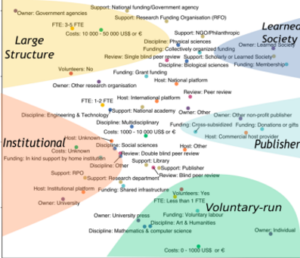OA Diamond Study shines a light
Today we are taking a look at the OA Diamond Journal Study, which dovetails nicely with this year’s Open Access Week theme of building structural equity.
Published in March this year and commissioned by cOAlition S and Science Europe this major study aims to illuminate the diverse ‘archipelago’ of small collaborative, non-commercial ‘Diamond’ Open Access journals and platforms. Diamond journals are Open Access venues that don’t charge for publishing services and therefore make a vital contribution to the ecology of Open Access and non-commercial scholarly communication. Tim Gower’s Discrete Analysis is a good example from Mathematics.
A significant effort went into the study between June 2020-February 2021 including a survey of 1,619 journals with 94 questions, crowd sourced data, 10 interviews with hosting platforms, 3 focus groups with 11 journals, and statistical analysis of bibliographic databases. In particular it inventoried 1048 journals unlisted in the Directory of Open Access Journals (DOAJ) and manually identified five Diamond journal types (Large Structure, Learned Society, Institutional, Publisher, and Voluntary-run, see Figure below).

In charting the topology of the Diamond OA landscape, the report concludes the following:
“In summary, OA diamond journals are very numerous, relatively small, often published by small university-based publishers, strong in HSS but important in other disciplines as well, and use the diamond model right from the moment of becoming accessible online.” https://doi.org/10.5281/zenodo.4558704, p.48
The study comprises Findings (203 pages), Recommendations, and their supporting data. There is a 2-page summary of the report’s main takeaways:
Key findings of the report:
- A vast archipelago (estimated at 29,000) of relatively small journals exists and serves a wide range of communities
- OA diamond journals are on the road to full compliance with Plan S
- Scientific strengths and operational challenges exist in a mix of areas from legal structures to technical capabilities to editorial processes or funding models
- OA diamond journals often depend on volunteers, universities and government to operate
Key recommendations:
- Streamline technical support
- Ensure compliance with Plan S (many are already well on the road to compliance)
- Build capacity for growth
- Increase effectiveness and efficiencies
- Sustain and invest in the future
Kick-start actions:
- Prepare an International Workshop and Symposium on OA diamond within 6 months to initiate a global conversation among different stakeholders
- Set up an OA diamond Funding Strategy within 1 year to implement funding recommendations
- Build the OA diamond Capacity Center within 2 years to support the implementation of recommendations
Diamond Open Access is an essential part of the scholarly publishing ecosystem, as it offers open access without article processing charges – which for some represents a barrier. By shedding a light on this form of scholarly communication this study helps the community better understand the pressures these journals face and share, and can hopefully help ensure these publication venues remain relevant and viable in the long term.